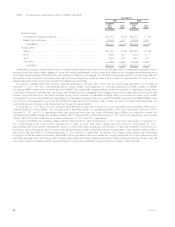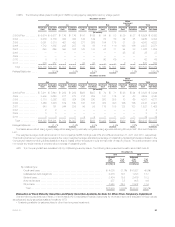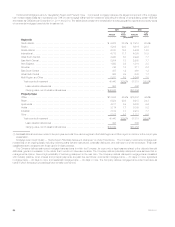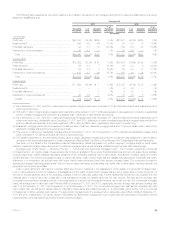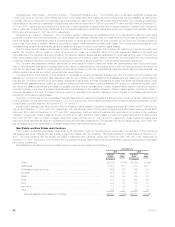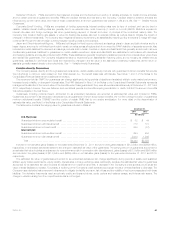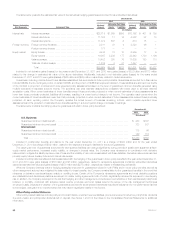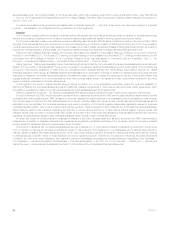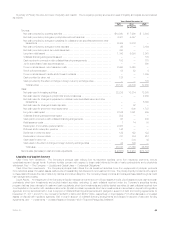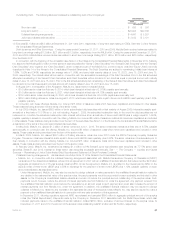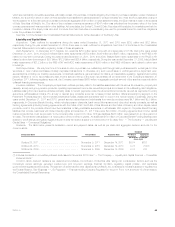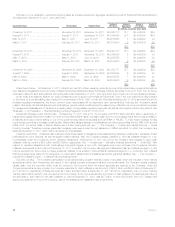MetLife 2011 Annual Report Download - page 64
Download and view the complete annual report
Please find page 64 of the 2011 MetLife annual report below. You can navigate through the pages in the report by either clicking on the pages listed below, or by using the keyword search tool below to find specific information within the annual report.Policyholder Liabilities
We establish, and carry as liabilities, actuarially determined amounts that are calculated to meet policy obligations when a policy matures or is
surrendered, an insured dies or becomes disabled or upon the occurrence of other covered events, or to provide for future annuity payments. Amounts
for actuarial liabilities are computed and reported in the consolidated financial statements in conformity with GAAP. For more details on Policyholder
Liabilities, see “— Summary of Critical Accounting Estimates.”
Due to the nature of the underlying risks and the high degree of uncertainty associated with the determination of actuarial liabilities, the Company
cannot precisely determine the amounts that will ultimately be paid with respect to these actuarial liabilities, and the ultimate amounts may vary from the
estimated amounts, particularly when payments may not occur until well into the future.
Our actuarial liabilities for future benefits are adequate to cover the ultimate benefits required to be paid to policyholders. We periodically review our
estimates of actuarial liabilities for future benefits and compare them with our actual experience. We revise estimates, to the extent permitted or required
under GAAP, if we determine that future expected experience differs from assumptions used in the development of actuarial liabilities.
Insurance regulators in many of the non-U.S. countries in which MetLife operates require certain MetLife entities to prepare a sufficiency analysis of
the reserves posted in the locally required regulatory financial statements, and to submit that analysis to the regulatory authorities. See “Business —
International Regulation” in the 2011 Form 10-K.
We have experienced, and will likely in the future experience, catastrophe losses and possibly acts of terrorism, and turbulent financial markets that
may have an adverse impact on our business, results of operations, and financial condition. Catastrophes can be caused by various events, including
pandemics, hurricanes, windstorms, earthquakes, hail, tornadoes, explosions, severe winter weather (including snow, freezing water, ice storms and
blizzards), fires and man-made events such as terrorist attacks. Due to their nature, we cannot predict the incidence, timing, severity or amount of
losses from catastrophes and acts of terrorism, but we make broad use of catastrophic and non-catastrophic reinsurance to manage risk from these
perils.
Future Policy Benefits
We establish liabilities for amounts payable under insurance policies. See Notes 1 and 8 of the Notes to the Consolidated Financial Statements for
additional information.
Insurance Products. Future policy benefits are comprised mainly of liabilities for disabled lives under disability waiver of premium policy provisions,
liabilities for survivor income benefit insurance, LTC policies, active life policies and premium stabilization and other contingency liabilities held under
participating life insurance contracts. In order to manage risk, the Company has often reinsured a portion of the mortality risk on new individual life
insurance policies. The reinsurance programs are routinely evaluated and this may result in increases or decreases to existing coverage. The Company
entered into various derivative positions, primarily interest rate swaps and swaptions, to mitigate the risk that investment of premiums received and
reinvestment of maturing assets over the life of the policy will be at rates below those assumed in the original pricing of these contracts.
Retirement Products. Future policy benefits are comprised mainly of liabilities for life-contingent income annuities, supplemental contracts with and
without life contingencies, liabilities for Guaranteed Minimum Death Benefits (“GMDBs”) included in certain annuity contracts, and a certain portion of
guaranteed living benefits. See “— Variable Annuity Guarantees.”
Corporate Benefit Funding. Liabilities are primarily related to payout annuities, including pension closeouts and structured settlement annuities.
There is no interest rate crediting flexibility on these liabilities. A sustained low interest rate environment could negatively impact earnings as a result,
however, the Company has employed various asset/liability management strategies, including the use of various derivative positions, primarily interest
rate floors and interest rate swaps, to mitigate the risks associated with such a scenario.
Auto & Home. Future policy benefits include liabilities for unpaid claims and claim expenses for property and casualty insurance and represent the
amount estimated for claims that have been reported but not settled and claims incurred but not reported. Liabilities for unpaid claims are estimated
based upon assumptions such as rates of claim frequencies, levels of severities, inflation, judicial trends, legislative changes or regulatory decisions.
Assumptions are based upon the Company’s historical experience and analyses of historical development patterns of the relationship of loss adjustment
expenses to losses for each line of business, and consider the effects of current developments, anticipated trends and risk management programs,
reduced for anticipated salvage and subrogation.
Japan and Other International Regions. Future policy benefits are held primarily for traditional life and accident and health contracts in Japan, Asia
Pacific and immediate annuities in Latin America. They are also held for total return pass-thru provisions included in certain universal life and savings
products mainly in Japan and Latin America, and traditional life, endowment and annuity contracts sold in various countries in Asia Pacific. They also
include certain liabilities for variable annuity guarantees of minimum death benefits, and longevity guarantees sold in Japan and Asia Pacific. Finally, in
Europe and the Middle East, they also include unearned premium liabilities established for credit insurance contracts covering death, disability and
involuntary loss of employment, as well as traditional life, accident and health and endowment contracts. Factors impacting these liabilities include
sustained periods of lower yields than rates established at issue, lower than expected asset reinvestment rates, actual lapses resulting in lower than
expected income, asset impairments, and actual mortality resulting in higher than expected benefit payments. The Company mitigates its risks by
implementing an asset/liability matching policy and through the development of periodic experience studies. See “— Variable Annuity Guarantees.”
Estimates for the liabilities for unpaid claims and claim expenses are reset as actuarial indications change and these changes in the liability are
reflected in the current results of operation as either favorable or unfavorable development of prior year losses.
Corporate & Other. Future policy benefits primarily include liabilities for quota-share reinsurance agreements for certain LTC and workers’
compensation business written by MetLife Insurance Company of Connecticut (“MICC”), prior to its acquisition by MetLife, Inc. These are run-off
businesses that have been included within Corporate & Other since the acquisition of MICC.
Policyholder Account Balances
PABs are generally equal to the account value, which includes accrued interest credited, but exclude the impact of any applicable surrender charge
that may be incurred upon surrender. See Notes 1 and 8 of the Notes to the Consolidated Financial Statements for additional information.
Insurance Products. PABs are held for death benefit disbursement retained asset accounts, universal life policies, the fixed account of variable life
insurance policies, specialized life insurance products for benefit programs and general account universal life policies. PABs are credited interest at a
rate set by the Company, which are influenced by current market rates. The majority of the PABs have a guaranteed minimum credited rate between
0.5% and 6.0%. A sustained low interest rate environment could negatively impact earnings as a result of the minimum credited rate guarantees. The
Company has various derivative positions, primarily interest rate floors, to partially mitigate the risks associated with such a scenario.
60 MetLife, Inc.


